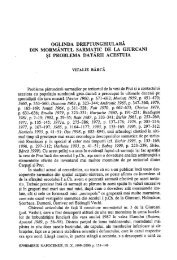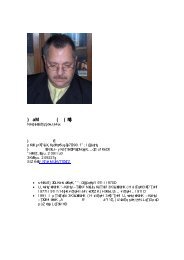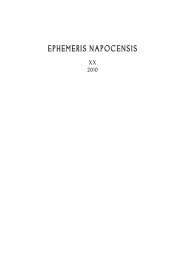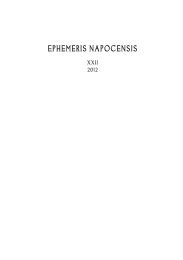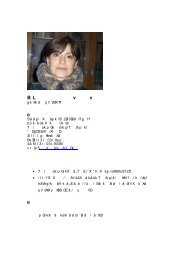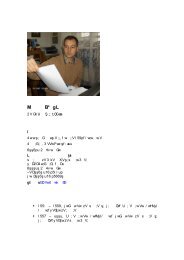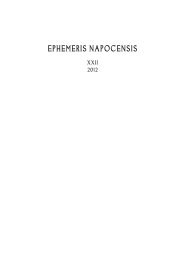ephemeris napocensis 2011 cu corectura.indd - Institutul de ...
ephemeris napocensis 2011 cu corectura.indd - Institutul de ...
ephemeris napocensis 2011 cu corectura.indd - Institutul de ...
Create successful ePaper yourself
Turn your PDF publications into a flip-book with our unique Google optimized e-Paper software.
118 Monica Guiset up altars and statues instead 34 . In<strong>de</strong>ed, some of the altars from Germisara were <strong>de</strong>dicated tothe Nymphs or to Aes<strong>cu</strong>lapius and Hygeia by military personnel, like T. Fabius Aquileiensis 35 ,the tribune of the aforementioned numerus, P. Aelius Marcellinus, signifer et quaestor of the sametroop, whose life was saved 36 (possibly by treatment at the baths), or M. Aurelius Mosianus, optioof the XIII Gemina legion 37 . At Aquae, a veteran who probably came here for treatment set upa votive altar for Her<strong>cu</strong>les 38 .Apart from these inscriptions found in and around healing places, few others can berelated to the subject. One example is known on the northern limes: C. Iulius Atianus, prefectof the ala I Tungrorum Frontoniana, is thankful to Aes<strong>cu</strong>lapius and Hygeia ob rest[itutam sibivaletudinem] 39 . Of course, only the obvious epigraphs were mentioned, but others might have asimilar un<strong>de</strong>rlying significance. An interesting case is that of an inscription <strong>de</strong>dicated to IupiterOptimus Maximus Dolichenus ex praecepto num(inis) Aes<strong>cu</strong>lapi somno monitus by a veteran of theXIII th legion, p(ro) s(alute) s(ua) suor(um)q(ue) 40 . The association of Dolichenus with Aes<strong>cu</strong>lapiusindicates that the former was un<strong>de</strong>rstood as having healing powers 41 and perhaps this parti<strong>cu</strong>laraspect of the divinity was being consi<strong>de</strong>red here for safeguarding the family’s good health.In conclusion, there is hardly any evi<strong>de</strong>nce that the rank and file were going to sanctuariesor spas. Maybe it’s just an acci<strong>de</strong>nt of inscription survival or they expressed their gratitu<strong>de</strong> in otherways. Or, it could be that, apart from a few veterans who se<strong>cu</strong>red for themselves a higher socialstanding, simple soldiers didn’t have access to places frequented by provincial governors, legionaryor auxiliary comman<strong>de</strong>rs, other officers and civil officials. Still, the votive monuments give us aglimpse of the way these people might have perceived medical treatment. It is beyond doubt theywere well aware of the <strong>cu</strong>rative effects of thermal waters and we can suspect some un<strong>de</strong>rwent actualmedical or surgical procedures. It is easy to imagine, for example, C. Iulius Frontonianus sufferingfrom cataract and seeing again after an operation. Cataract extraction, although requiring someskills and great care, was pretty straightforward and had a high success rate 42 . So, while someancient medical texts do make a distinction between rational and irrational forms of medicine 43 ,for these people it is all too clear that the gods are responsible for their regained health.3. Closer to the forts: thermae and valetudinariaIt is safe to assume that every fort had thermae, and some have been excavated, likethe military baths from Slăveni 44 , Micia 45 , Inlănceni 46 , Mehadia 47 , Romita 48 , Potaissa 49 etc. Itappears that only a small quantity of archaeological material is known from these sites, eitherbecause it hasn’t been fully published, or it’s largely missing due to later human or natural<strong>de</strong>struction. However, the finds from Romita do give us an i<strong>de</strong>a on the kinds of small things34PISO/RUSU 1990, 14.35PISO/RUSU 1990, 16–17, no. 11 = ILD, 329 = AE 1992, 1487.36CIL III, 1396 = IDR III/3, 243.37AE 1993, 1341 = ILD, 319.38CIL III, 1406 = IDR III/3, 8.39CIL III, 786.40CIL III, 1614 = IDR III/5.1, 220.41POPA/BERCIU 1978, 9–10.42JACKSON 1986, 151; JACKSON <strong>2011</strong>, 257.43Celsus, De Medicina, Prooemium.44POPILIAN 1971.45MARINESCU/MĂRGHITAN/PETOLESCU 1975.46GUDEA 1979, 167–170.47MACREA/GUDEA/MOȚU 1993, 69–74.48MATEI/BAJUSZ 1997.49BĂRBULESCU/CĂTINAȘ/LUCA/HUSAR/HUSARIK/GREC/BĂRBULESCU1999.



